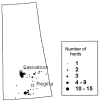Survey of Mycobacterium avium subspecies paratuberculosis serological status in beef herds on community pastures in Saskatchewan
- PMID: 12125186
- PMCID: PMC341943
Survey of Mycobacterium avium subspecies paratuberculosis serological status in beef herds on community pastures in Saskatchewan
Abstract
Johne's disease is a well recognized problem in dairy herds. Relatively little information is available on either the prevalence or the control of Johne's disease in commercial cow-calf operations. In the fall of 1999, blood samples were collected during pregnancy testing from cows on community pastures in Saskatchewan. Sera from these cows were analyzed using a commercial ELISA for antibodies to Mycoplasma avium subspecies paratuberculosis. All cows from each herd examined at the community pastures were sampled. Of the 1799 samples tested, 15 had sample to positive (S/P) ratios greater than 0.25 and were considered positive (apparent sample prevalence, 0.8%; 95% CI, 0.4% to 1.5%). If we assume test sensitivity of 25% and specificity of 98% as recommended by the National Johne's Working Group, the true sample prevalence is not significantly different from 0.0%. The ELISA S/P results for the antibody test-positive animals ranged from 0.27 to 2.5. If a herd was classified as positive based on one test-positive animal, the average herd apparent prevalence was 15.2% (95% CI, 7.1% to 28.6%). If the potential for false-positive results was considered with 2 or more positive animals being required for positive herd status, the herd prevalence was 3.0% (95% CI, 0.4% to 13.4%). Because of the very low prevalence in cow-calf herds, future research to identify risk factors and control points should target problem herds and utilize a case-control study design.
Figures
Similar articles
-
Sensitivity of test strategies used in the Voluntary Johne's Disease Herd Status Program for detection of Mycobacterium paratuberculosis infection in dairy cattle herds.J Am Vet Med Assoc. 2002 Apr 1;220(7):1053-7. doi: 10.2460/javma.2002.220.1053. J Am Vet Med Assoc. 2002. PMID: 12420786
-
Prevalence of antibodies against Mycobacterium avium subsp paratuberculosis among beef cow-calf herds.J Am Vet Med Assoc. 2001 Aug 15;219(4):497-501. doi: 10.2460/javma.2001.219.497. J Am Vet Med Assoc. 2001. PMID: 11518178
-
[The suitability of ELISA for the detection of antibodies against Mycobacterium avium ssp. paratuberculosis in bulk milk samples from Rhineland-Palatinate].Berl Munch Tierarztl Wochenschr. 2007 Jan-Feb;120(1-2):67-78. Berl Munch Tierarztl Wochenschr. 2007. PMID: 17290945 German.
-
Characteristics (sensitivity and specificity) of herd-level diagnostic tests for Mycobacterium avium subspecies paratuberculosis in cattle - A systematic review.Vet J. 2022 Jan;279:105786. doi: 10.1016/j.tvjl.2022.105786. Epub 2022 Jan 10. Vet J. 2022. PMID: 35026383
-
Johne's disease in Canada Part I: clinical symptoms, pathophysiology, diagnosis, and prevalence in dairy herds.Can Vet J. 2006 Sep;47(9):874-82. Can Vet J. 2006. PMID: 17017652 Free PMC article. Review.
Cited by
-
Seroprevalence of and agroecological risk factors for Mycobacterium avium subspecies paratuberculosis and neospora caninum infection among adult beef cattle in cow-calf herds in Alberta, Canada.Can Vet J. 2007 Apr;48(4):397-406. Can Vet J. 2007. PMID: 17494367 Free PMC article.
-
Seroprevalence of Mycobacterium avium spp. paratuberculosis in cow-calf herds located in the prairie provinces of Canada.Can Vet J. 2022 Dec;63(12):1247-1251. Can Vet J. 2022. PMID: 36467383 Free PMC article.
-
Estimating the sensitivity and specificity of serum ELISA and pooled and individual fecal PCR for detecting Mycobacterium avium subspecies paratuberculosis in Canadian cow-calf herds using Bayesian latent class models.Front Vet Sci. 2022 Jul 29;9:937141. doi: 10.3389/fvets.2022.937141. eCollection 2022. Front Vet Sci. 2022. PMID: 35968010 Free PMC article.
-
Systematic review of the prevalence of paratuberculosis in cattle, sheep, and goats in Latin America and the Caribbean.Trop Anim Health Prod. 2014 Dec;46(8):1321-40. doi: 10.1007/s11250-014-0656-8. Epub 2014 Aug 30. Trop Anim Health Prod. 2014. PMID: 25169696
-
Seroprevalences of antibodies against bovine leukemia virus, bovine viral diarrhea virus, Mycobacterium avium subspecies paratuberculosis, and Neospora caninum in beef and dairy cattle in Manitoba.Can Vet J. 2006 Aug;47(8):783-6. Can Vet J. 2006. PMID: 16933557 Free PMC article.
References
-
- Goodger WJ, Collins MT, Nordlund KV, et al. Epidemiologic study of on-farm management practices associated with prevalence of Mycobacterium paratuberculosis infections in dairy cattle. J Am Vet Med Assoc 1996;208:1877–1881. - PubMed
-
- Johnson-Iferulundu Y, Kanneene JB. Distribution and environmental risk factors for paratuberculosis in dairy cattle herds in Michigan. J Am Vet Med Assoc 1999;60:589–596. - PubMed
-
- Ott SL, Wells SJ, Wagner BA. Herd-level economic losses associated with Johne's disease on US dairy operations. Prev Vet Med 1999;40:179–192. - PubMed
-
- United States Department of Agriculture. Info Sheet — Veterinary Services: What Do I Need to Know About Johne's Disease in Beef Cattle? Fort Collins, Colorado: Centers for Epidemiology and Animal Health, United States Department of Agriculture, 1999: pp 4.
-
- Ollis G, VanderKop M. Johne's disease surveillance: A baseline study in beef cattle. Anim Health Forum 2000;5(2):6.
Publication types
MeSH terms
Substances
LinkOut - more resources
Full Text Sources



